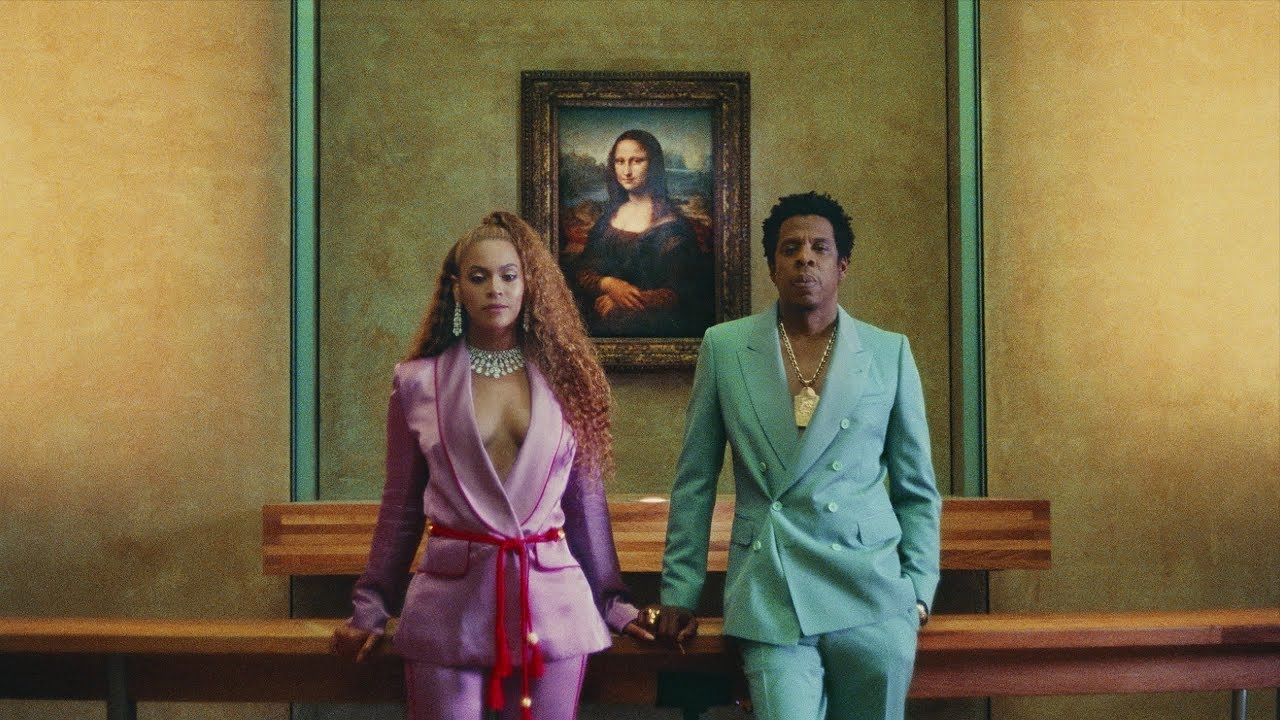Everything Is Love, the 9-track album released on June 16, 2018, by Beyoncé and Jay Z (now a collaborative group named “The Carters”) currently has one music video, for the lead single “APESHIT”. Two musical powerhouses on their own, Beyoncé and Jay Z have combined for an album that seems like the result of Lemonade, 4:44, and some marriage counseling sessions culminating in a fun, forward-looking, Black album. Quite possibly the most important aspect of Everything Is Love is its embrace of blackness (from the lyrics to the cover art to the models and dancers used), as well as its positioning of Black bodies as the center of artistic attention and praise. Here are four reasons why Everything Is Love, specifically the music video for “APESHIT” and the cover art for the album, are culturally as well as historically significant:
1. The Creators.
First of all, it’s two black superstars of different music genres collaborating! On top of that, they’re a married couple with their own separate long lists of accolades. This is “Hip Hop’s Royal Couple”. Hip Hop’s “First Family”. Hip-hop, as a relatively young genre, hasn’t really ever seen artists – artists who are still creating music and performing it – get married, grow up, have kids, and still maintain such a remarkably tight chokehold on the industry and the culture. Furthermore, it’s important to recall Beyoncé and Jay Z’s past visual work when analyzing just how significant Everything Is Love is; and we don’t have to look far. They both released some of their most mature and Black-centric albums in the last two years, with Lemonade’s release in 2016 and 4:44’s release in 2017.
2. The Pattern … It Continued.
The “APESHIT” music video continues in the trend set by Lemonade and 4:44 by continuing to place Black bodies at the forefront of previously or typically white-dominated spaces. In the music video for “Sorry” off of Lemonade, Beyoncé and girls like Zendaya Coleman, Amandla Stenberg, Winnie Harlow, Quvenzhané Wallis, and Chloe and Halle Bailey pose on the steps of an old plantation house, once the property of a slave owner. Beyoncé took the place where black bodies were used as commodities and flipped it into a power play, a sign of resistance, a sign of reclamation. Beyoncé also used another strong black woman to really bite back at this nation’s abhorrent history: Serena Williams. Twerking in the same place that young slave girls used to carry the whip for a master “so mean he was close to the devil” took back a space never meant for black people and then injected it with the sort of black womanhood that our ancestors could never have imagined. Jay Z follows suit in the music video for “Moonlight” off of 4:44. Hov took one of the most recognizable and popular white sitcoms of the past decade and replaced each famous white cast member with an up-and-coming Black media personality, successfully portraying the shift in the spotlight as Black creators come into their own in an industry that is changing, whether it likes it or not.
3. The History of Where It Was Filmed.
The Louvre is one of, if not the most, famous museums in the world. Its original purpose was to be a fortress, but it was turned into a royal palace and finally, a museum. In all three of its forms, the Louvre was devoid of black skin, any shade. We were not to be protected, we were not royal, and we were not works of art – so there was no place for us. This is why Beyoncé and Jay Z renting out a historical landmark to blast a strident, aggressive beat with Quavo of the Migos ad-libbing in the background while Hip-Hop’s Royal Family raps about equity, Black wealth, and turning down offers to perform at the Super Bowl, is so noteworthy. The whitewashed history of the Louvre, from its founding to its paintings, is why a music video of “APESHIT”’s proportions is so culturally significant.

4. What It Means For Hip-Hop.
As hip-hop and its cultural importance evolve, so does its visual representations, what artists of the genre choose to depict, and what it gains access to. Hence, the Louvre hosted a hip-hop video from two industry stalwarts in 2018, when all we used to do was rap about visiting it in an attempt to showcase our elevated social statuses (“I admit, my first watch was a Fossil, now I’m in the Louvre, lookin’ for fossils”). And it’s not just about Beyoncé and Jay Z having big enough names or enough social or monetary capital to pull this off; Kim Kardashian and Kanye West reportedly could not rent out the Louvre or the Palace of Versailles for special occasions. The Carters rented the Louvre with barely a month’s notice and then stationed Black bodies pulsating on the steps while others did hair in front of the Mona Lisa. The camera pans out from the Mona Lisa’s face to Beyoncé’s and Jay Z’s (both of whom are standing a very close, yet respectful distance, away), staring deadpan yet powerfully into the lens. Beyoncé moves in a flurry, twirling the “expensive fabrics” she mentions, while several Black boys kneel as a nod to Colin Kaepernick and Jay Z raps in an all-white suit in front of paintings like “Portrait of a Black Woman (Negress)” by Marie-Guillemine Benoist and sculptures like “Winged Victory of Samothrace”. This is a piece of Black media that not many could have envisioned. The very presence of an afro pick is disruptive to the history of the Louvre. This white- and male-dominated space had a Black woman throw an MCM hat at the camera in a show of unabashed Black joy and power. This was all to create one of the most unique and triumphant pieces of Black media in hip-hop, ever. I don’t know about you, but this video screams cultural and historical significance to me. It’s never been done before, and anything like it that’s done after will only be in homage to the originators.



